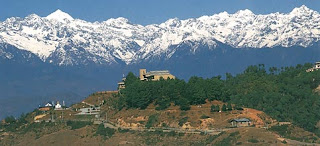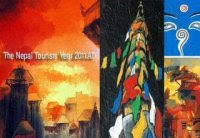
Synchronizing the tradition of mysticism and beliefs, Kumari is the realism of abstract practice of worshipping a pre-pubescent girl or Virgin in the most profound way of defining culture. The strong image, beautiful ornaments and the flashy red color, portrays her image where she stands as a powerful symbol of unity, prosperity, peace and health.
Literally meaning the virgin, the Kumari represents a strong symbol of power and culture enslaved in the rich colors of festivity which manifests a variation of tradition in the form of goddess as a KUMARI. Kumari is believed to be the bodily incarnation of the goddess Taleju Bhawani (Shakti) where the image highlights a great presence and acceptance among the scattered communities and people. The ideology of veneration of Kumari as the living goddess dates back to centauries which to this day glorify the rich tradition in fulfilling the centuries old practice of KUMARI.
Like such, the east manifests different traditions, which are abstract and enigmatic to its identity but defines the richness in the most profound way where people beliefs and values passes the normal limits. The rich cultural heritage and the profound beliefs, explores the different possibilities in playing with the colors of traditions and culture giving it the shapes of a montages in chanting the unique colors of life. These cultural aspects promulgate unity in the diversity standing as a focal point of beliefs.
Many stories and myths are surrounded with the origination of Kumari but the popular one goes back to the Malla Dynasty to King Jaya Prakash Malla.
According tot the saying, Telaju Bhanwan was the main deity of the Malla kings, so she was prized with honor and respect in the Malla kingdom, apart from that the one of the Malla kings had pleased the goddess and has granted him a wish to meet him every day. Every day the Malla king use to play Pasa (Dice Game) with the goddess Taleju Bhawani. Though the goddess audience the king every night but the goddess had shadowed her presence with in curtain where she restricted any human to see her and only her voice would stage her presence. One day, the Malla King with in the temptation of seeing the goddess crossed his limits and peeped into the curtain, the Goddess with anger of breaking the promise disappeared. The king called upon all his magicians and priests and consulted them and after hearing their suggestion he worshiped the goddess and made her happy. Then she returned and told the king that, if he wants to see her again or have her protect his country, he'd have to search her among the Newar (Shakya) community, as she would be incarnated as a little girl among them. Hoping to make amends with his patroness, the tradition of Kumari started giving it the form of tradition and festivity. After that, the search of the Kumar started one after the other where girls were selected with specific criteria to fulfill the cultural custom of KUMARI.
The criteria for selection of a Kumari are listed as below:
Ø The candidate must be born in the Buddhists from the Newar Shakya caste
Ø The girl must posses the 32 characters of women from physical to mental for e.g. Skin blemish free, Black hair and eyes, body need to be sturdy, hands and feet dainty, small and well-recessed sexual organs, a set of twenty teeth etc
Ø The candidate’s horoscope must have certain attributes of planets and starts
Ø The candidate must be strong and fearlessness, during the tests. The candidate must withstand an odiferous room of blood and demon-like masked dancers to test her willpower and strength, if the candidate cries or fear the situation she is immediately disqualified
Ø And a series of Tantric rituals and tests will be perform for determining the goddess in the form of a young girl
After the beginning selection process, the selected candidate has to go through many rigorous processes to prove being worth of a Kumari. Her greatest test comes during the Hindu festival of Vijaya Dashami (Dashain). On the eight night day of Dashain, Kalratri, (the night of darkness) 108 buffaloes and goats are sacrificed in honor of goddess Kali. On that day the preferred candidate is taken to the temple and is released into to the Mul Chowk (Courtward). Different tantric procession and tantric dances are performed by masked dancers where her physical and mental strength is tested to the level. As a final test the candidate has to spend a whole night alone in a room with the sacrificed animal heads. If the candidate possesses the qualities of Taleju, she shows no fear and faces the test with confidence but if the candidate shows fear then she is considered to be mortal and is backed out of the contest.
After overcoming these tests, she is announced as the Kumari where she is sent to the Kumari Ghar and resides inside till she evacuates the position. Declared as a Kumari, now she transforms into a goddess where she is considered as holy and each and every word and action that she displays counts. Her feet, like all of her, are now sacred; people will touch them, hoping to receive blessings of long life health and prosperity. She is allowed to do everything from normal activities to play but she is restricted with in the Kumari Ghar. The child will stay in the temple, and will be allowed to return to her family only at the onset of menstruation or if she wounds her self and bleeds. It’s believed that bleeding makes her invalid for worship where the new search begins. The presence and image of Kumari is considered auspicious where people flock in every day to get the glimpse her.
The Kumari Ghar is the palace of the Kumari where she resides in her glorious tradition. The abode in-houses magnificent intricate carvings and great architecture where at time she audiences her arrivals from a window. The Kumari Ghar is well equipped with care takers, priests and other necessary people who serve under the Kumari in assisting her with her daily chores and processions. Guthi Sansthan, a government trust fund bears her entire expenses including that of her caretakers.
Recorded Names of KUMARIof NepalName: Hira Maiya Shakya
Hometown: Wotu
Date of service: 1922-1923
Name: Chini Shova Shakya
Hometown: Lagan
Date of service: 1923-1931
Name: Chandra Devi Shakya
Hometown: Asonchuka
Date of service: 1931-1933
Name: Dil Kumari Shakya
Hometown: Lagan
Date of service: 1933-1942
NameNani: Shova Shakya
Hometown: Ombahal
Date of service: 1942-1949
NameKayo Mayju Shakya
Hometown: Kwahiti
Date of service: 1949-1955
Name: Harsha Laxmi Shakya
Hometown: Naghal
Date of service: 1955-1961
Name: Nani Mayju Shakya
Hometown: Naghal
Date of service: 1961-1969
Name: Sunina Shakya
Hometown: Ombahal
Date of service: 1969-1978
Name: Anita Shakya
Hometown: Sikamoobahal
Date of service: 1978-1984
Name: Rashmila Shakya
Hometown: Kwahiti
Date of service: 1984-1991
Name: Amita Shakya
Hometown: Asanbahal
Date of service: 1991-2001
Name:Preeti Shakya
Hometown: Itumbahal
Date of service: 2001-2008
Name: Matina Shakya
Hometown: Kathmandu
Date of service: 2008-Present
During the festival of Indra Jatra, in the month of September, the Kumari come out in public for the Kumari Jatra where she travel on her jeweled chariot through the older part of Kathmandu city in a three tiered chariot accompanied by Ganesh and Bhairab. Thousand of Kathmanduties throng to Basnatapur durbar square for the festivity which creates a gala of attraction.
Nevertheless, the tradition of the Living Goddess KUMARI is a mystery of religion and enigma which create its own attraction in the most prolific way of giving it the shape and size of cultural icon.
Abstract yet enigmatic in defining the tradition of the east, Kumari is a reality of 21st century that manifests the social ground upholding the holistic image adoring the sharp Red engulf in a strong presence. The Kumari portrays an aura of goddess where she stands as a symbol of power and culture uniting people of Nepal in the most appropriate form of culture.






















